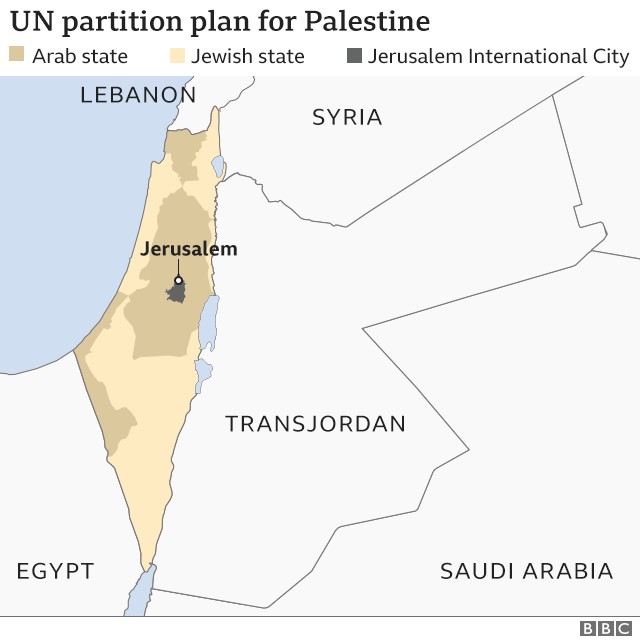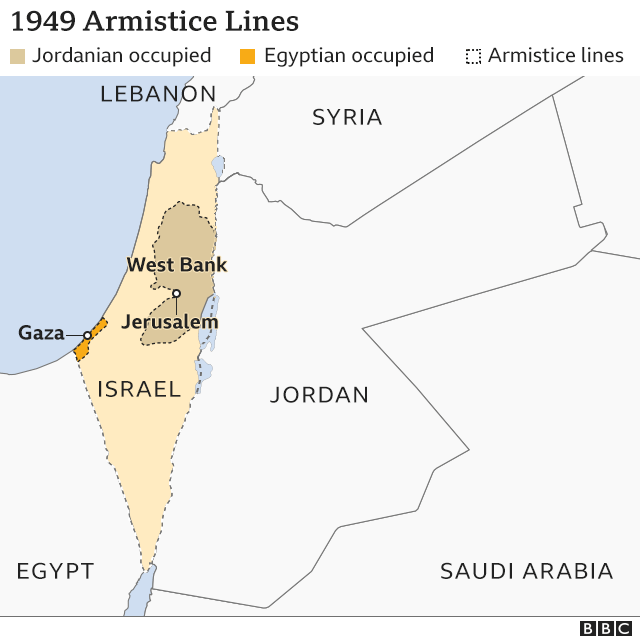I’m nervous. I’m not into politics or religion, and this one has both. And despite watching the American news, I have no idea what’s going on at a foundational level. Or maybe it’s because I watch the American news. Either way, I’ve decided to take on the project myself. Here’s the Israeli-Palestinian conflict in about 1200 words.
Reminders
The area of discussion is sandwiched between the Mediterranean Sea and the Jordan River, accounting for about 10,500 square miles of land. That’s approximately two and a half times smaller than West Virginia, the tenth-smallest and relatively anonymous US state.
In terms of population, the region under discussion has around 14 or 15 million people, i.e. 1.1% of India’s population and 0.18% of the world’s population.
Background
While boiling the conflict down to just a religious one is too simplistic, it’s worth having a little background.
Around 2000 BCE, the ancestors of modern Jews were in nomadic tribes under the patriarch Abraham. God promised a permanent home to Abraham and his descendants in the region of interest. (Refer to the Old Testament for further detail.) Over the ensuing centuries, Jews endured difficult times, including enslavement in Egypt, the destruction of Solomon’s Temple and subsequent exile at the hands of the Babylonians (587 BCE), and the destruction of a rebuilt temple and repeat exile at the hands of the Romans (70 CE). Ultimately, the Jewish people found themselves dispersed throughout the world, creating a Jewish diaspora.
In 570 CE, Muhammad, the founder of Islam (another Abrahamic religion), was born. Islam spread throughout the Arabian peninsula and beyond, with many Arabs becoming Muslim.
Of course, the Abrahamic religion that came to prominence between the aforementioned two, namely Christianity, also maintains relevance in the Arab world.
The city of Jerusalem, located in the region of interest, is important to all three religions. God’s presence (Judaism), Jesus’ crucifixion, and Muhammad’s ascension to heaven are all believed by worshippers to be part of Jerusalem’s history.
Setting the Stage
The story picks up steam in the late 1800s. At that time, what we know today as Israel/Palestine was still under control of the Ottoman Empire.
Meanwhile, Jews in parts of Europe (particularly Russia) weren’t exactly feeling the love, finding themselves persecuted and occasionally killed. This persecution prompted the emigration of many Jews to places like the United States. It also provided momentum for modern Zionism, or establishment of a Jewish state in the region of interest. (Zion is used in the Hebrew Bible as a synonym for Jerusalem.) Given that the exile at the hands of the Romans (referenced above) had occurred around 1800 years prior, the land was largely occupied by members of the other two Abrahamic religions.
As World War I approached its end in 1918, former Ottoman holdings were carved up by the Allied Powers. Under a future League of Nations mandate, termed the Mandate for Palestine, the region called Palestine was placed under British administration. Part of the plan was to establish a home for Jews in Palestine as long as the civil and religious rights of existing non-Jewish communities (i.e. Palestinian Arabs) were respected. History would prove this task to be much easier said than done.
Driven by ongoing atrocities in Europe, the number of Jews in the region increased over the years, increasing tension with Palestinian Arabs. As the process accelerated, Britain handed the situation over to the United Nations (the successor of the League of Nations), which in 1947 proposed a solution. The plan encompassed an independent Jewish state, an independent Arab state (with multiple noncontiguous pieces of land), and the international territory of Jerusalem. (See the map below, courtesy BBC.) The plan was accepted by Jewish leaders but rejected by Palestinian Arabs.

1948 to Now
In 1948, Britain moved on and Jewish leaders declared the creation of the state of Israel. This latter act was not taken to kindly, prompting the Arab-Israeli War between the new country and several Arab nations. As a result of the war, Israel’s existence was solidified, and its land area extended beyond what the United Nations had envisioned. The West Bank and East Jerusalem were occupied by Jordan, and Gaza was occupied by Egypt. Here’s a map, courtesy BBC again.

A byproduct of the war was the beginning of another diaspora, this time the Palestinian diaspora. In contrast, the Jewish diaspora in places like Yemen, North Africa, and many others found its way to Israel.
During the Six-Day War of 1967, Israel took control of the West Bank, all of Jerusalem, and Gaza. (It also acquired Golan Heights, still disputed with Syria, and the Sinai Peninsula, which was returned to Egypt after the 1973 Yom Kippur War.) Since this time, borders have remained rather hazy, with certain pieces of land considered part of Israel in the minds of some and occupied by Israel in the minds of others. Israeli settlements in the West Bank continue to be a major point of contention, as is the concept of Israel as the sole possessor of Jerusalem. The latter controversy was illuminated further when in 2018 the US placed an embassy in Jerusalem, recognizing the city as Israel’s capital.
Over the years, Palestinian uprisings (or intifadas) have had violent outcomes, the first starting in 1987 and the second in 2000. After the most recent intifada, a physical barrier was created separating Jerusalem from the West Bank. Israel left Gaza in 2005, though this gesture did little to improve relations. Various attempts at peace have ultimately been fruitless, with the Oslo Accords of the 1990s being a prominent example.
Palestine is viewed as an independent state by some members of the United Nations but not others. Relations with surrounding Arab nations are complex. Of the two Palestinian portions, Gaza has suffered a worse fate. Surrounded by the Mediterranean Sea, an unfriendly Egypt, and Israel, options for its impoverished civilians are limited. It remains under the control of the political party Hamas, viewed by many as an Islamist terrorist organization given its denial of Israel’s right to exist. Hamas receives funding from allies including Iran and has made a habit of firing rockets into Israel. The Palestinian Liberation Organization (PLO) runs the government in the West Bank, known as the Palestinian National Authority, with the major political party being Fatah. In its past, the PLO sought the destruction of Israel, though it now accepts the country’s right to exist.
As for Israel, it has one of the highest per-capita military expenditures in the world. The country is surprisingly diverse, with about 21 percent of the population being Arab and 18 percent Muslim. Arabs are well-represented in the Israeli Parliament. In addition to Hebrew, languages such as Arabic, Russian, Amharic, French, and English are commonly heard.
Unfortunately, simmering tension continues to define the region, with intermittent violence triggered by what outsiders might perceive as relatively minor events. A definitive solution is not forthcoming.
Keep your ears open for further goings on regarding the Israeli-Palestinian conflict. It’s never far from the news. Of course, the news doesn’t always explain what’s going on.
Addendum: In October 2023, Hamas launched a devastating surprise attack in Israel, resulting in the death of hundreds of innocent civilians. The Israeli military responded in short order, and an escalation of violence not seen in years is ongoing.
15 Responses
Very enlightening and well presented article. The historical coverage gives an insight into the present day occurrences. Originating from a country with similar history, definitive solutions are challenging.
Thank you. Yes, history and faith are key to understanding why the conflict has no easy answers.
A brief & precise ( for me – non political , non -religious person).
As a student of military history ,what is amazing is that Israel , surrounded by hostile Arab nation has emerged triumphant in all conflicts except for Yom Kippur war of 1973 in which Israel although beat back the attackers had to accept few compromises.
That’s a great point. Israel’s military success has been remarkable.
There is also a historic back ground that can explain the Israeli military supremacy.
The founders of Israel had a secular, progressive background, equipped with the military legacy and support of the industrial west, while Arabs at that time were just emerging blind after they stayed in the dark, gloomy regressive chamber of the Ottoman Empire for seven centuries; hence, they lost most of their battles.
As Napoleon once said “ God always favor big battalions “ .
Thanks for presenting this as a concise timeline.
Thanks for reading!
Thank you for this succinct overview of the history that makes understanding the current events much easier!
Appreciate you reading it!
This post is great for those of us who have been thinking of reading about the history of the conflict but never really got around to doing it. Thank you!
Thank you!
Hi Amol, as a person who spend considerable time living the conflict this brief account of this historical conflict reflects a lot of objective facts in a fair, well phrased abstract.
Thank you…would love to hear more about your experiences.
The summary is factual. Only thing omitted is the Jewish settlement in West bank, after PLO accepted the existence of Iseral.
Yes, that is a major point of contention (among others). It was mentioned briefly, but thanks for highlighting it.